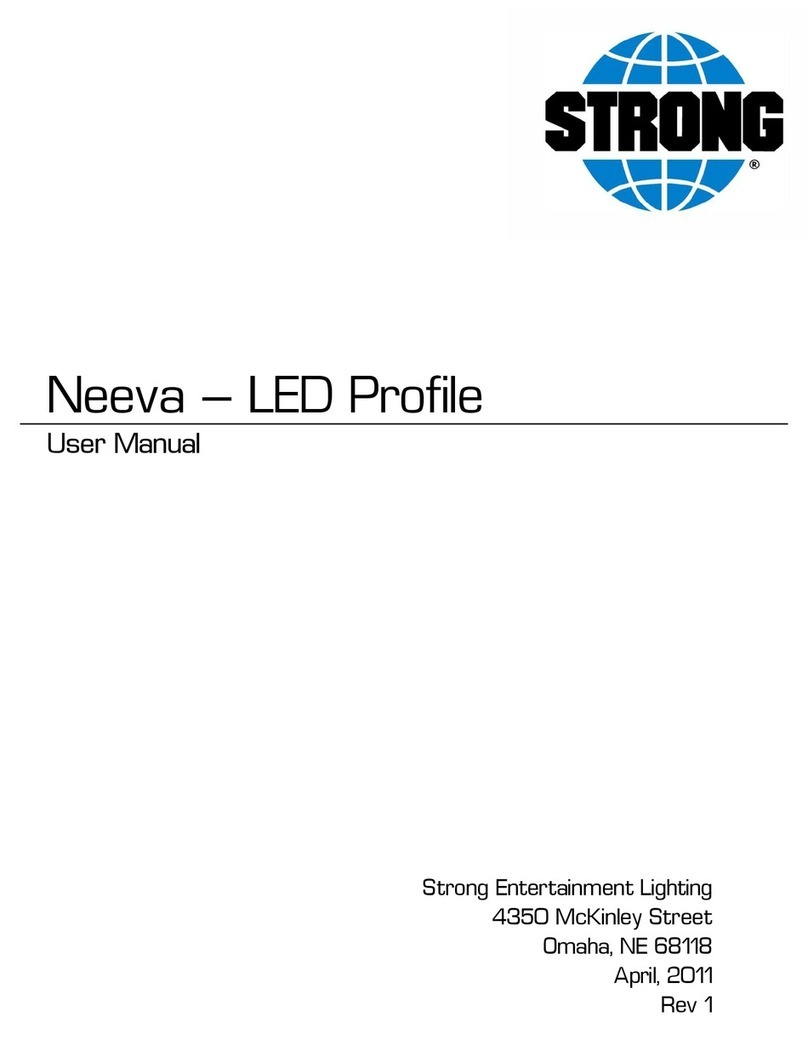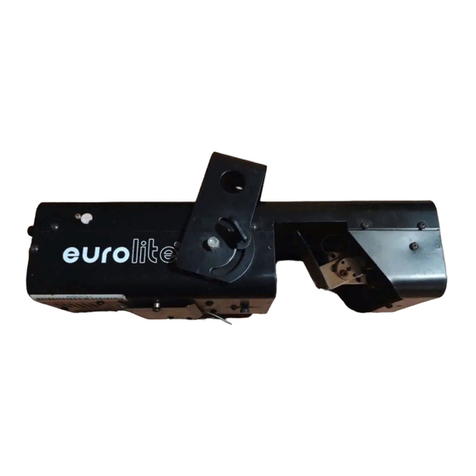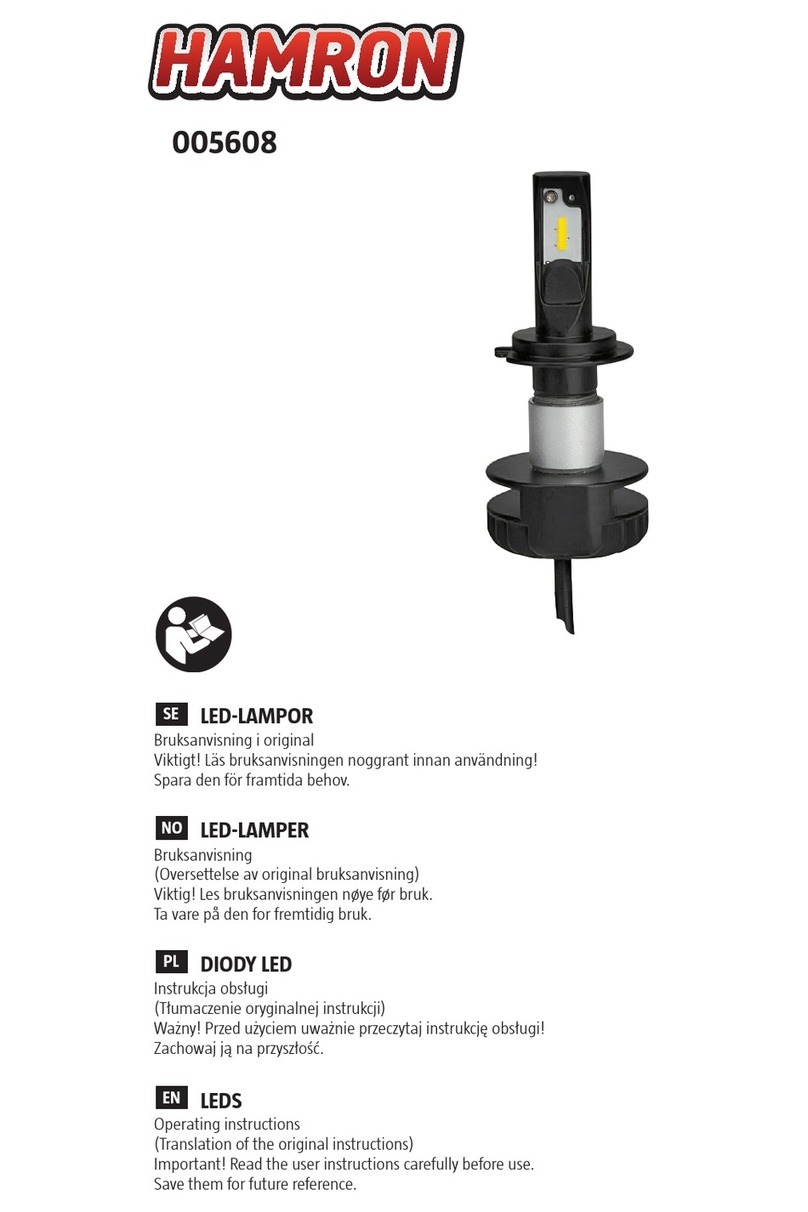Strong XENON SUPER TROUPER User manual

XENON SUPER TROUPER
Follow Spotlight
Type 83050, 83070
Rev. 11/99
STRONG INTERNATIONAL
a division of Ballantyne of Omaha, Inc.
4350 McKinley Street
Omaha, Nebraska 68112 USA
Tel 402/453-4444 • Fax 402/453-7238


PREFACE
THE STRONG XENON SUPER TROUPER is a direct current follow spotlight
system complete with a xenon lamphouse, power supply, optical system, base and yoke assembly,
and six-color boomerang.
ONLY THE SPECIAL XENON POWER SUPPLIES manufactured by Strong
International can be used with the xenon spotlight. For installation and operation of the power supply,
see the manual furnished separately.
THE XENON LAMPHOUSE utilizes a deep ellipse dichroic metal reflector designed
to operate in a fixed position with a horizontally mounted xenon bulb as the light source. A heat filter
is located in the front of the lamphouse to reduce the heat at the optical system and color boomerang.
ONLY XENON BULBS designed for horizontal operation should be used in this spot-
light. The presently approved ratings for bulbs used in this spotlight are 1000, 1600, and 2000 watt.
See the listing in this manual for the approved types and necessary adapters.
ADJUSTMENT CONTROL for positioning the xenon bulb is located at the rear of
the lamphouse. The adjustments are for the horizontal, vertical, and focus control of the bulb.
THE LAMPHOUSE INSTRUMENT PANEL is equipped with an ammeter and
running time meter. The ammeter indicates the operating current of the lamp, and the running time
meter records the number of hours the lamp has operated.
THE BULB is ignited and extinguished by use of the LAMP switch mounted on the
instrument panel. Remote ignition switching is accommodated by wiring a five ampere dry contact
across wires 3 & 6. See the Interconnection Wiring Diagram.
THE LAMP BLOWER, internally wired in the lamp, operates on 115 V.AC and is
required to keep the seals on the bulb at a safe operating temperature. This blower will operate
continuously until power is turned off at the main line switch to the xenon power supply. An air flow
switch in the lamphouse prevents operation of the xenon lamp if the blower is not operating, or the
airflow is inadequate.
THE LAMPHOUSE is supplied with a 13 foot cable containing the two DC leads, the
ground lead, and all AC control leads. The cable terminates in a multiple pin MS connector to mate to
the receptacle on the power supply.
WHEN TRANSPORTING the follow spotlight, it is recommended that the xenon bulb
be removed from the lamphouse and placed in its original shipping carton with the cover on the bulb to
prevent breakage.
XST/001

LAMPHOUSE - POWER SUPPLY
Interconnection Diagram
LAMPHOUSE
(Connections Pre-wired) MS CONNECTOR
Pin Wire No,
A DC-
B DC+
C 2
D 3
E 4
F 5
G 6
I 7
J 8
M Grnd
Lamphouse
Cable Assembly
Conduit
Remote - Auto
Sustained 5 Amp.
Dry Contact
(by Installer)
XENON
POWER
SUPPLY
MS Connector (pre-wired)
DC+
DC-
Ground Lug
(as req’d. for older units)
Grn
SYSTEM MUST BE GROUNDED
All wiring must conform to local
codes; shield lamphouse cable in
conduit if required.
XST/002

XST/003
INSTALLATION AND SETTING UP SPOTLIGHT
THE XENON SUPER TROUPER is shipped in sections which must be assembled.
The Folding Base Stand Assembly 65826 (if supplied; see Figure 6A) is shipped collapsed, and re-
quires only folding down and pinning the base legs. The following paragraph applies only to the rigid
base assembly 83793 (see Figure 6).
ASSEMBLE the four base legs to the square section of the center tube using the 3/8-
16 x 2-3/4 inch hex head cap screws and lock washers supplied. Insert a leveling foot and locknut in
each of the four leg brackets and level the base before proceeding with the installation.
WHEN INSTALLED in a permanent location, the leveling feet must be removed, and
the clearance holes in the base leg brackets used for hardware (user supplied) to bolt the base to the
floor or platform. If it is desired to have the unit portable, when operating, the leveling feet must be
adjusted down until the weight of the spotlight has been shifted from the casters to the leveling feet.
THE INNER TUBE and support yoke has three holes to permit adjusting the height of
the spotlight. The three holes are on four inch centers and will allow an optical height of approximately
53 inches, 57 inches, and 61 inches above floor level to the optical center of the lamphouse and lens
system. The leveling feet may be adjusted through an additional two inch range. Insert the height
location pin through the hole in the outer tube and one of the holes in the inner tube.
THE HORIZONTAL SWING and vertical tilt locking knobs are on the right hand
(operating) side of the yoke assembly. Tighten both of these locking devices securely before attempting
to place the lamphouse and lens system on the support yoke.
PLACE THE LAMPHOUSE and lens system on the yoke assembly, with the spot size
control handle to the right hand (operating) side, the same as the locking controls on the yoke. Line up
the four mounting holes in the bottom of the base rail with the four mating holes in the support yoke
and secure with the four 5/16-18 wing screws.
ATTACH THE COLOR BOOMERANG to the front of the optical system by inserting
the hinge pin through the hinge on the boomerang and optical system. Fasten the boomerang yoke to
the slotted angle bracket on the underside of the optical system pan. Adjust and securely tighten the
wing nut and lock nuts to hold the boomerang parallel with the front of the optical system housing.
ATTACH THE LAMPHOUSE CABLE connector to the receptacle on the power
supply. Align the pins before tightening the locking ring. Early model lamphouse cables include a
separate ground lead; secure the green ground lead to the ground terminal on the outside of the
power supply housing. Do not energize the xenon power supply before first installing the xenon
bulb into the lamphouse.

SAFETY PROCEDURES
THE XENON BULB is highly pressurized. When ignited, the normal operating temperature
of the bulb increases the pressure to a level at which the bulb may explode if not handled in strict accordance to
the manufacturer’s operating instructions. The bulb is stable at room temperature, but may still explode if
dropped or otherwise mishandled.
REFER bulb replacement and service to QUALIFIED PERSONNEL with adequate protective
clothing (face shield, clean cotton gloves, welder’s jacket). For routine lamphouse service, observe the follow-
ing rules:
1. Allow the bulb to cool to room temperature before opening the lamphouse. Put on protective clothing
described above.
2. De-energize the xenon power supply at the AC source before opening the lamphouse compartment.
3. When possible, encase the bulb in its protective cover when cleaning or servicing the lamphouse inte-
rior. The bulb, when outside the lamphouse, must be encased in the cover.
4. Clean the bulb after it has cooled to room temperature. Do not touch the quartz envelope of the bulb;
fingerprints will burn in and create hot spots which may shorten bulb life. If fingermarks are made,
they should be carefully removed with methyl alcohol and cotton prior to bulb operation.
5. Never view an ignited bulb directly. BLINDNESS OR PERMANENT EYE DAMAGE MAY BE
INCURRED.
6. Use only xenon bulbs designated as OZONE FREE. When possible, vent the lamphouse exhaust to
outside atmosphere.
7. Maintain the lamphouse blower in good operating condition. Keep the blower inlet clean for unre-
stricted air flow.
8. To insure maximum bulb life, operate the lamphouse blower and the exhaust system for at least ten
minutes after extinguishing the bulb.
9. If returning a bulb for warranty adjustment, pack it in its original shipping container. Complete and
return all required warranty information.
10. Dispose of expired bulbs that are beyond warranty in the following manner: Wrap the bulb tightly in
several layers of canvas or heavy cloth. Place it on a hard surface and shatter the envelope with a sharp
hammer blow. DO NOT place an unshattered bulb in an ordinary refuse container.
11. DO NOT PERMIT UNAUTHORIZED PERSONNEL TO PERFORM OR ATTEMPT ANY PHASE
OF XENON BULB HANDLING OR SERVICE.
Cathode End Cap
Envelope
Anode End Cap
Anode Pin
Seal Anode Cathode
Trigger Wire Cathode Pin
Seal
XST/004

1. Fade-Out Mechanism Control Lever
2. Masking Shutter (Chopper) Control Lever
3. Iris Control Lever
4. Spot Size Control Handle
5. Color Boomerang
6. Spot Focus Knob
7. Leveling Foot
8. Horizontal Swing Control Lever
9. Vertical Tilt Control Lever
10. Lifting Strap
11. Cap, Exhaust Stack
XST/005

EXHAUST SYSTEM INSTALLATION
IF THE SPOTLIGHT is installed in a closed booth, it is recommended to vent the
lamphouse exhaust to outside atmosphere to remove the heat from the booth.
THE EXHAUST STACK of the lamphouse is designed to fit a six-inch diameter duct.
The exhaust system must be designed and installed is a way to eliminate any possibility of a down draft
or of rain dripping into the lamphouse. The exhaust fan must be capable of removing 750 lineal feet
(150 cfm) of air per minute at each lamphouse.
TO PERMIT MOVEMENT of the follow spotlight, install a section of six-inch diam-
eter flexible tubing between the lamphouse exhaust stack and the projection booth exhaust system.
The two holes in the stack exposed by removing the vent cap can be used to secure the tubing.
IF THE INSTALLATION is to be made in a location where it is not possible to install
an exhaust system, leave the vent cap mounted to the exhaust stack.
THE RADIATION from some xenon bulbs can convert the oxygen in the surrounding
air to ozone. In large quantities, ozone can endanger health, but it spontaneously changes back into
oxygen in a very short time, especially if it mixes with a large volume of air (as in an auditorium, arena,
or outdoors). Most currently manufactured xenon bulbs are classified as ozone free and do not release
ozone.
XST/006

1. Cap, Exhaust Stack
2. Top Cover, Lamphouse
3. Access Panel, Igniter
4. Cover, Bulb Adjust
5. Current Control (early models)
6. Elapsed Time Meter
7. Ammeter
8. MODE Switch (AUTO-MAN.)
9. LAMP Switch (ON-OFF)
XST/007

Item No. OSRAM 1 kW OSRAM 1.6 kW Hanovia 1 kW Hanovia 1.6 kW
1 65199 65199 65259 65403
2 00720 00720 00720 00720
3 XBO1000W/HS XBO1600W/HS XH1000HS XH1600HS
4 65198 65198 65198 65198
BULB ADAPTERS, 1000 & 1600 WATT BULBS
XST/008

BULB INSTALLATION
CAUTION: OBSERVE ALL SAFETY PROCEDURES. Put on the protective face
mask. Wear clean cotton gloves to prevent marking the quartz envelope of the bulb with fingerprints.
REMOVE THE TOP COVER of the lamphouse by removing the four Holt head
(tamperproof) screws with the special screwdriver provided.
NO BULB ADAPTERS are required to install the 2000 watt bulb in the 83070 Xenon
Super Trouper lamphouse. Adapters used to install the 1000 watt or 1600 watt bulb in the 83050
lamphouse are supplied in the accessory kit. See the Bulb Adapter Chart for the correct adapters and
sequence of assembly.
ASSEMBLE THE REQUIRED ADAPTERS to the 1000 or 1600 watt bulb prior to
inserting the bulb into the lamphouse. Be very careful not to apply any strain on the quartz envelope
when installing adapters. Screw the threaded cathode adapter on the negative stud so it seats firmly
against the shoulder of the (-) end cap. Slip the anode adapter with set screw over the positive stud,
up to the shoulder of the (+) end cap. Tighten all fasteners securely to insure a good electrical connec-
tion.
REMOVE THE PLASTIC PROTECTIVE COVER from the xenon bulb only if nec-
essary. Insert the bulb through the top of the lamphouse, between the reflector support and the front
casting. Pass the anode (+) end of the bulb through the hole in the reflector, taking care not to touch
the surface of the reflector.
INSERT THE ANODE ADAPTER STEM of 1000 and 1600 watt bulbs into the rear
support collet. The stem must be inserted as far as possible to permit full focus travel of the bulb.
Place the cathode adapter into front bulb support, pivot the retaining plate to its closed position, and
tighten the (2) thumb screws. Tighten the socket head clamping screw in the anode contact securely
to insure a good electrical contact.
INSTALL THE CATHODE LEAD CONTACT over the end of the cathode adapter
up to the shoulder of the contact and tighten the clamping screw securely. Lay the lead in front of the
air duct to minimize the shadow.
THE 2000 WATT bulb mounting components include a shock mount support at the
front of the lamphouse. Insert the 2000 watt bulb through the top of the lamphouse, passing the anode
(+) end through the hole in the reflector. Pass the anode pin as far as possible to the rear of the
lamphouse to permit sliding the cathode (-) end cap through the ring of the shock mount. Insert the
anode pin into the bulb support collet and firmly tighten the socket head clamping screw. Slide the
cathode contact clamp over the cathode pin and tighten securely.
XST/009

AN ALTERNATE METHOD of installing the 2000 watt bulb is to dismount the shock
mount ring from the front bulb support assembly by removing the socket head screw. Slide the ring
over the cathode (-) end cap of the bulb, and install the bulb by inserting the anode (+) end cap through
the reflector center hole and seating the anode pin into the rear support collet. Re-mount the ring to
the base of the front bulb support using the socket head screw. Secure the anode (+) clamping screw;
install and tighten the cathode (-) contact clamp.
THE SOCKET HEAD SCREW which mounts the bulb support ring to its support
bracket must be tightened securely enough to clamp the upright bulb support ring in a vertical (90°)
position and prevent its tilting forward or back as the bulb is focused. The end cap of the bulb should
touch only the coils of the shock mount spring to allow the bulb to slide forward and back with a
minimum of friction and no stress on the quartz envelope.
OBSERVE THE POSITION of the Trigger Wire on the 2 kW xenon bulb relative to
the point where the bulb passes through the center hole of the reflector. Some bulb manufacturers
attach one end of the trigger wire to the anode end cap; if this trigger wire approaches the reflector too
closely, the DC current will follow this path to ground and prevent bulb ignition. To avoid this, detach
the trigger wire from the anode end cap and loop it around the bulbous portion of the envelope as
illustrated on the line drawing at the end of the SAFETY PROCEDURES page.
XENON BULBS WITH LEADS may be used in the lamphouse. A terminal stud
located on the air duct casting has been provided for connecting a bulb cathode lead with the negative
lamphouse lead. Remove the contact and clamp from the negative lamphouse lead. Attach the lamp-
house lead and bulb lead in contact with each other, under the hex nut on one side of the terminal stud.
This stud should not be used as a feed-through terminal.
AN ANODE LEAD attached to a bulb must be coiled around the bulb adapter and
secured to the igniter lead with the 1/4-20 x 3/8" head head cap screw used to connect the igniter lead
to the contact clamp. The socket head clamping screw must be tightened to fix the position of the bulb.
IT IS RECOMMENDED to establish a routine for periodically checking all electrical
connections for tightness, particularly those at the bulb. A loose connection in the DC circuit will
cause failure of the contacts and leads, and may destroy the bulb.
THE REFLECTOR is optically positioned at the factory. Do not alter the position of
the reflector by adjusting the tie rod located in the upper corner of the lamphouse.
XST/010

65198
XBO1000W/HSC;
XBO1600W/HSC
00710 Set Screw
65359 Adapter
Bulb Anode Lead
NOTE:
Two Turns
Clamp
00805 Hexnut
Igniter Output Lead
CAUTION: Dress lead
away
from grounded
lamphouse components Igniter 1. Dismount Contact Clamp from Igniter Lead. Slide Clamp
over brass socket in rear support collet.
2. Attach Adapters (65198 & 65359) to Bulb. Securely tighten
both 00710 Set Screws.
3. Install Bulb as instucted in preceding section.
4. Tighten rear clamping screw; wrap Bulb Lead around 65359
Adapter using Two Turns.
5. Connect Igniter Lead to ring terminal of Bulb Lead using the
1/4-20 screw removed from the Contact Clamp (Step 1)
and a 00805 Hexnut. Dress well away from back casting.
BULB MOUNTING - OSRAM TYPE “HSC”
(with Anode Lead)
XST/011

01532
65410
00687
00389
83747
65131
01532
65844
REAR OF LAMPHOUSE
OBSERVE CORRECT POLARITY
Part No. Description
00687 Lead Mounting Screw
01532 Clamping Screw
00389 Bulb Support Mounting Screw
65131 Anode (+) Contact Clamp
65410 Cathode (-) Contact Clamp
65844 Rear Bulb Support Collet, 2 kW
83747 Front Bulb Support Assembly
NOT SHOWN
65948 Negative (-) Lead Assembly
65966 Positive (+) Lead Assembly
2000 Watt Operation: 75 Amperes Nominal
DO NOT EXCEED 90 AMPERES
2000 WATT BULB INSTALLATION
XST/012
Position Ring at 90°(as shown)
and tighten Clamping Screw

OPERATION
REMOVE THE PLASTIC COVER from the xenon bulb. Do not ignite the lamp with
the cover on the bulb.
A GLASS HEAT FILTER is supplied to reduce the temperature at the optical system
and color gels. Insert the heat filter in the bracket provided on the inside of the lamphouse at the front
opening. Place the filter in position with the coated surface facing the bulb. The coated surface is
indicated by a small XX or other marking. This filter is a narrow strip that covers only the center
portion of the beam. To prevent damage to optical system components, do not operate the spotlight
with the filter removed or reversed.
SECURE THE LAMPHOUSE COVER with the (4) tamperproof screws using the
special screwdriver provided. The cover must be securely in position to actuate the interlock switch
and permit lamp ignition.
PLACE THE MODE SWITCH (on units so equipped) in the “MAN.” position and
energize the xenon power supply. The lamphouse blower will start and actuate the blower interlock
switch to permit bulb ignition. This lamp blower will operate continuously until the xenon power
supply is de-energized.
PLACE THE LAMP SWITCH in the ON position and the xenon bulb will ignite.
Allow a few minutes for the current to stabilize, and read the lamphouse ammeter. The bulb must be
operated within the current range specified by the bulb manufacturer. The ranges for the Hanovia bulb
supplied with the unit are as follow:
WATTAGE NOMINAL CURRENT DO NOT EXCEED
1000 50 A. 58 A.
1600 65 A. 70 A.
2000 75 A. 90 A.
ADJUST THE POWER SUPPLY as instructed in the power supply manual for the
correct operating current. The current setting must be increased in time to compensate for bulb aging,
but do not, at any time, exceed the maximum current rating.
REMOVE THE REAR COVER PANEL (two pull-type knobs) to expose the bulb
position adjustment control.
THE CENTER SECTION of the control is a threaded member that focuses the bulb in
relation to the reflector. Turning this adjustment moves the bulb on the horizontal plane, into or out of
the reflector. Rotating this section clockwise moves the bulb away from the reflector. The small
knurled screw to the left of this section can be tightened to lock the focusing mechanism in place after
the bulb alignment procedure has been completed.
XST/013

THE THUMB SCREWS to the left and right of the focusing control lock the horizon-
tal and vertical position of the bulb.
TWO METHODS, detailed following, are recommended to align the bulb in order to
project the best light to the stage.
MOVE THE SPOT SIZE CONTROL HANDLE on the large lens carriage to the
forwardmost position to project the smallest spot possible with the iris, choppers, and dimming con-
trol in the full open position. Project the spot to a wall or similar flat perpendicular surface opposite
the spotlight.
TURN THE CENTER FOCUS CONTROL counterclockwise until a small black spot
is projected on the wall. It may be well to run this adjustment both directions to permit positive
identification of the dark spot.
LOOSEN THE TWO THUMB SCREWS to the left and right of the focus control just
enough to permit manual movement of complete control assembly. Move the control assembly around
the two thumb screws and observe the smooth dark shadow of the bulb electrode inside the shaded
circle of the reflector center opening. The shadow of the electrode must be centered in the projected
opening of the reflector.
MOVE THE CONTROL ASSEMBLY around the thumb screws until the dark elec-
trode shadow is as round as possible to project. It may be necessary to again rotate the focus control
to define the electrode shadow.
AFTER THE ELECTRODE SHADOW is as even around the outside as possible,
tighten the two thumb screws to lock this adjustment in place, and rotate the focus control to obtain
the brightest light with the best light distribution. Turn the spot focus control knob, located on the
front of the lens mechanism, to sharpen the edge of the spot.
THE SECOND METHOD of aligning the xenon bulb is to project the spot to the
stage, and using the bulb adjustment controls, obtain a “hot spot” in the projected spot. Center this
“hot spot” in the projected spot by moving the entire control section around the two thumb screws.
Focus Lockscrew
Thumb Screw Focus Control
BULB ADJUSTMENT CONTROLS
XST/014

Once the “hot spot” is centered in the projected spot, lock the adjustment control in position with the
two thumb screws and rotate the focus control to obtain a spot with an even distribution of light. Turn
the spot focus control knob at the front of the lens mechanism to sharpen the edge of the spot.
THIS ADJUSTMENT should not be disturbed until the xenon bulb is replaced. At this
time it will be necessary to repeat the alignment procedure.
REPLACE THE REAR COVER PANEL over the bulb adjustment control mecha-
nism. Secure using the plastic fasteners.
BECAUSE OF MANUFACTURING TOLERANCES and normal bulb aging, it may
be necessary to operate one lamp at slightly higher or lower current than others to obtain equal light
balance between units. These adjustments are made at the xenon power supply.
TO EXTINGUISH THE ARC, place the LAMP switch in the OFF position. The
blower in the lamphouse will continue running until the xenon power supply is de-energized. Allow
the blower to operate and cool the bulb for at least five minutes after extinguishing. This measure will
prolong bulb life.
TO OPERATE THE SPOTLIGHT from a remote location or an automation con-
troller, the lamphouse must be equipped with the MODE (Auto-Man.) switch. With the MODE
switch in the “AUTO” position, and the LAMP switch “ON,” the lamphouse will ignite by means of
a dry contact across terminals 3 and 6 at the lamphouse or power supply (See Lamphouse-Power
Supply Interconnection Diagram). This type of installation is intended for use only if the spotlight is
“locked down” as a fixed spot without an operator at the unit.
XST/015

HANDLING THE SPOTLIGHT
GENERALLY THE BEST POSITION for the operator to stand is near the center of
the spotlight, on the right hand side, although the angle of tilt and the size of the porthole may alter the
position for the most convenient operation.
EACH OPERATOR will, after a few minutes of operation, generally develop his own
system and position for operating the unit.
THE HORIZONTAL SWING LOCK LEVER and vertical tilt lock lever located on
the base assembly can be set to give the desired amount of friction on the spotlight swing to suit the
individual operator.
THE LENS CARRIAGE FRICTION BRAKE is a nylon drag screw located on the
outrider of the large lens carriage, and is preset at the factory for most satisfactory operation. Indi-
vidual requirements may vary, and the brake can be adjusted to best suit the operator or allow for a
severe “down” angle. Remove the color boomerang and lens mechanism housing, loosen the nylon
lock nut and adjust the screw on the friction brake to apply the desired tension. Tighten the lock nut
and replace the housing and boomerang.
XST/016

OPERATION OF OPTICAL SYSTEM
THE IRIS CONTROL is the front lever which projects through the top of the optical
system housing. When this lever is to the left (as viewed from the rear of the unit), the largest aperture
is provided. Smaller apertures are obtained as the lever is moved to the right.
THE SPOT SIZE CONTROL HANDLE is located on the right hand side of the opti-
cal system just above the base rail. A variation of spot sizes from full flood to small spot can be
obtained by moving the spot size control handle from one extreme to the other. Beam intensity is
increased by this optical system when reducing from flood to spot, and maximum intensity is reached
when the spot size control handle is in the extreme forward position.
THE MAXIMUM FLOOD SPOT is obtained with the iris control lever to the left
(away from operating side) for the largest aperture and with the spot size control handle moved as far
to the rear as possible.
SMALLER SIZED SPOTS are projected as the spot size control handle is moved
forward. Most of the spot sizes needed will be produced with the iris in its maximum open position.
FOR A “HEAD SPOT,” or any spot smaller than can be obtained with the spot size
control handle in its extreme forward position, shift the iris control lever to the right (toward operating
side) for a smaller aperture. The iris control lever should always be returned to its extreme left
position before the spot size control handle is again moved to obtain larger spots.
THE MASKING SHUTTER (chopper) lever is the middle lever projecting through
the top of the optical system housing. The masking shutter blades are operated by this lever to shape
the projected spot to a rectangle, strip spot, or dousing.
THE DISENGAGED POSITION of the masking shutter lever is to the extreme right
(toward operating side) and varying degrees of masking to complete cutoff are obtained by moving
the lever to the left (away from operating side).
THE ANGLE of the masking shutter blades can be adjusted to compensate for the
horizontal projection angle. Remove the color boomerang and optical system housing, and loosen the
screws holding each of the masking shutter blades enough to allow movement. Ignite the bulb and
adjust the angle of the bottom blade by tapping with a screwdriver so its projected edge lies parallel to
the footlights. Tighten the screw. Operate the masking shutter lever to close the blades. Adjust the
upper blade to close in line with the bottom blade and tighten the screw.
THE FADEOUT MECHANISM AND DOUSER CONTROL is the rear lever pro-
jecting through the top of the optical system cover. This lever controls the intensity of light from
complete fadeout when the lever is to the left, to full intensity when the lever is to the right.
XST/017

THE SPOT FOCUSING CONTROL KNOB is located on the operating side of the
optical system at the forward end above the base rail. This control is used to position the lenses of the
optical system for the length of throw. When making an adjustment, rotate the spot focusing control
knob until the sharpest edge is obtained on the projected spot.
A SLOT in the lens mechanism housing, between the optical system controls and the
front lens, allows insertion of special media such as frost gels. Additional frame holders (83746) may
be ordered from Strong International dealers.
OPERATION OF COLOR BOOMERANG
THE COLOR BOOMERANG is equipped with six color filters and provision has been
made for installation of an optional ultraviolet filter. The ultraviolet filter may be purchased as an
accessory (Order No. 51829) and is easily mounted to the front of the boomerang. Additional filter
holders (51928 & 51376) can be supplied by your Strong International Dealer.
TO OPERATE INDIVIDUAL COLOR FILTERS, lower the desired filter selector
lever. A rocker catch located in the color disc housing holds the filter in position.
TO RELEASE A COLOR, push the filter release arm up or engage another color, thus
releasing the previous color automatically.
TO REPLACE A FILTER HOLDER, open the hinged top of the color disc housing
and lift out the desired filter holder.
NOTE: WHEN PLACING COLOR FILTERS in the boomerang, the less dense col-
ors should be placed in the holders toward the rear of the boomerang (toward arc), and those of
greater density should be placed in the holders toward the front of the boomerang (away from the
arc).
COLOR TEMPERATURE REDUCTION FILTERS, required for use with television
and videotape, are available from theatrical supply dealers.
XST/018
Table of contents
Other Strong Lighting Equipment manuals
Popular Lighting Equipment manuals by other brands
EuroLite
EuroLite LED Pixel Spot 64 DMX user manual

Velvet
Velvet Light Series user manual
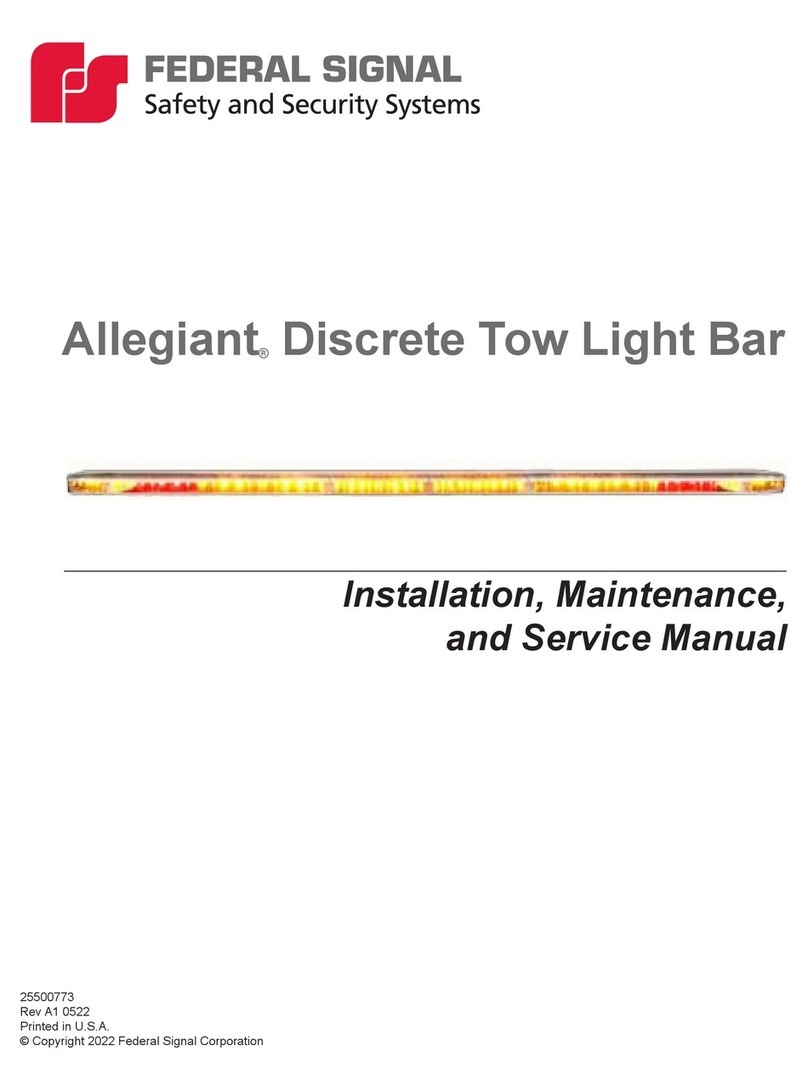
Federal Signal Corporation
Federal Signal Corporation Allegiant ALGT61 Installation maintenance and service manual

Gama Sonic
Gama Sonic GS-126 instruction manual
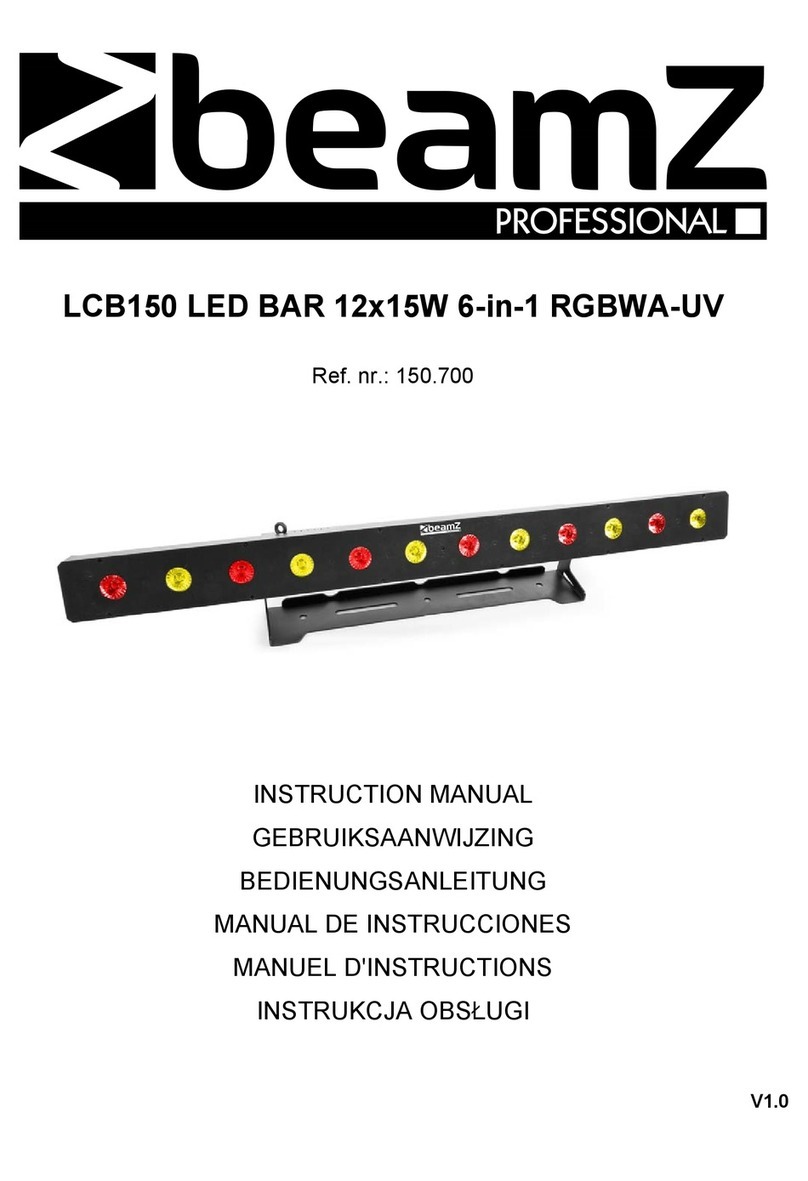
Beamz
Beamz LCB150 instruction manual

LIVARNO home
LIVARNO home 366612-21-A instruction manual
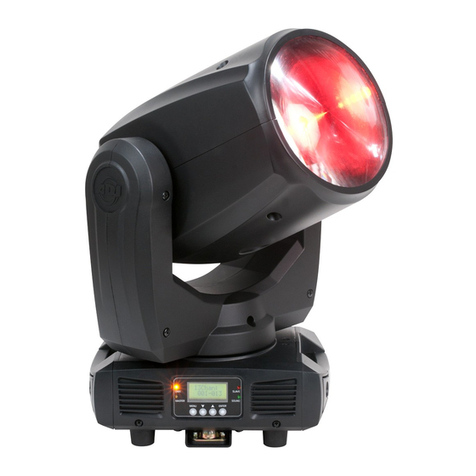
American DJ
American DJ Inno Color Beam LED User instructions
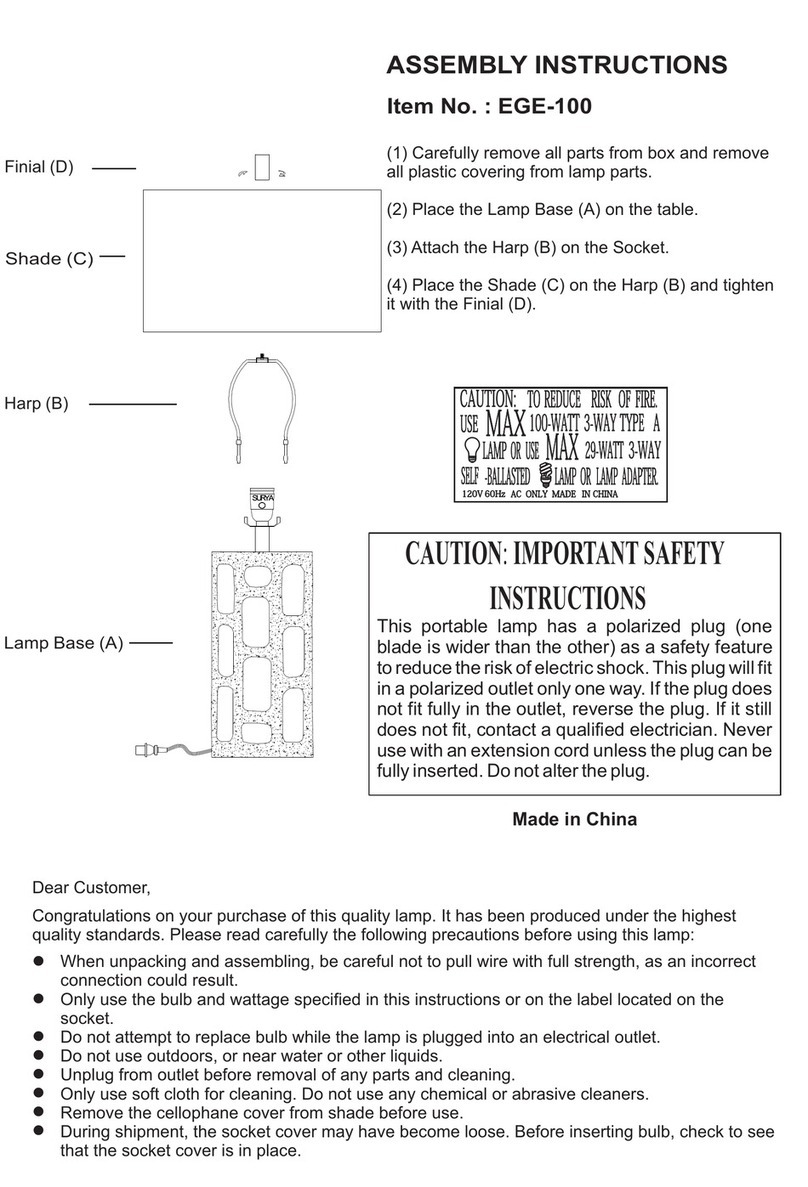
Living Spaces
Living Spaces EGE-100 Assembly instructions

Chauvet
Chauvet Quad-9 user manual

Chauvet
Chauvet Freedom user manual

Würth
Würth LED-SABER WL1 Translation of the original operating instructions
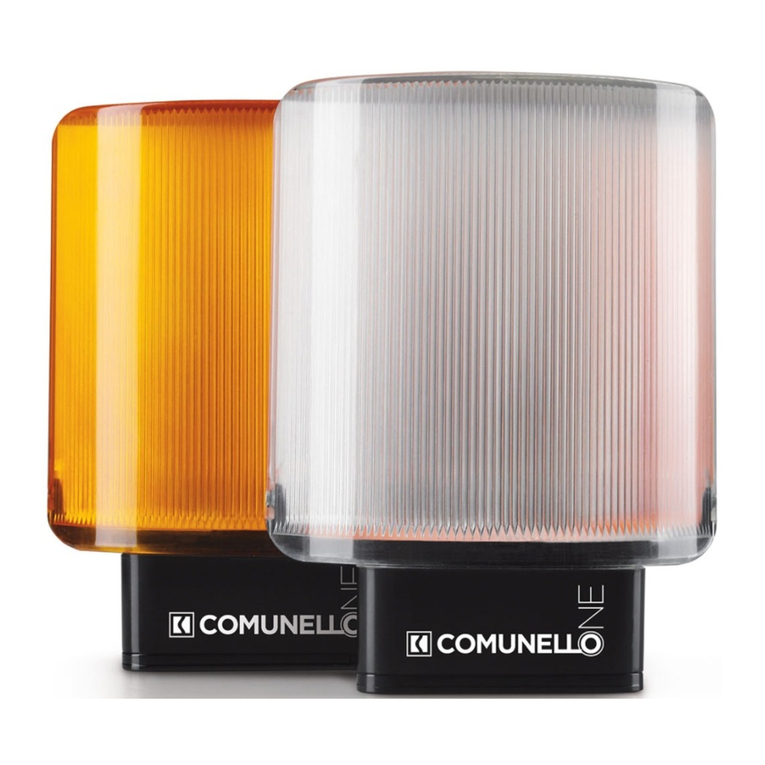
Comunello Automation
Comunello Automation SWIFT Installation and user manual
